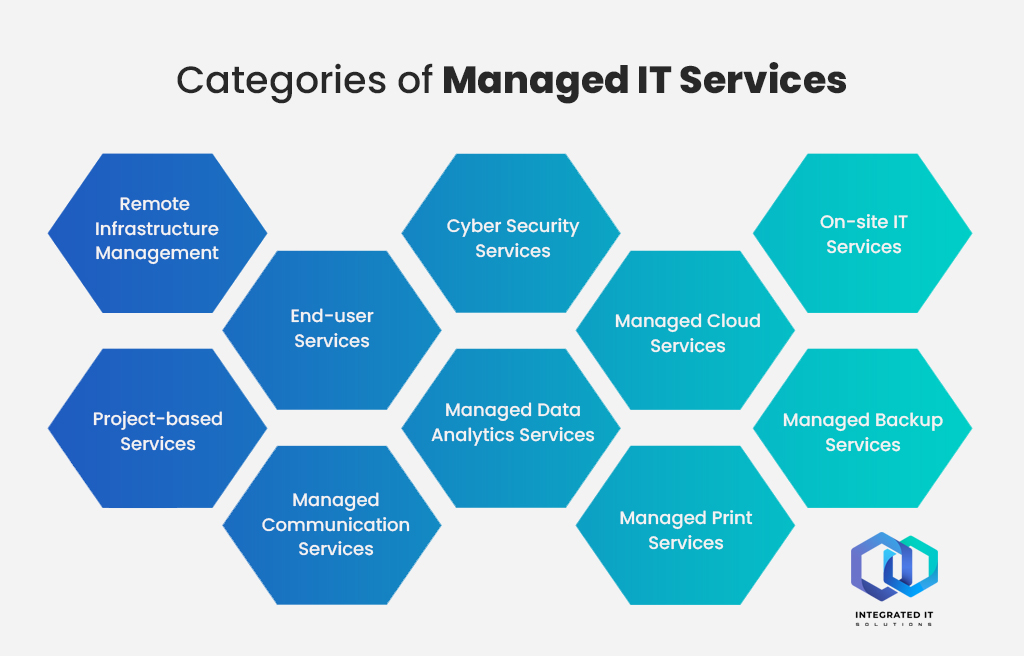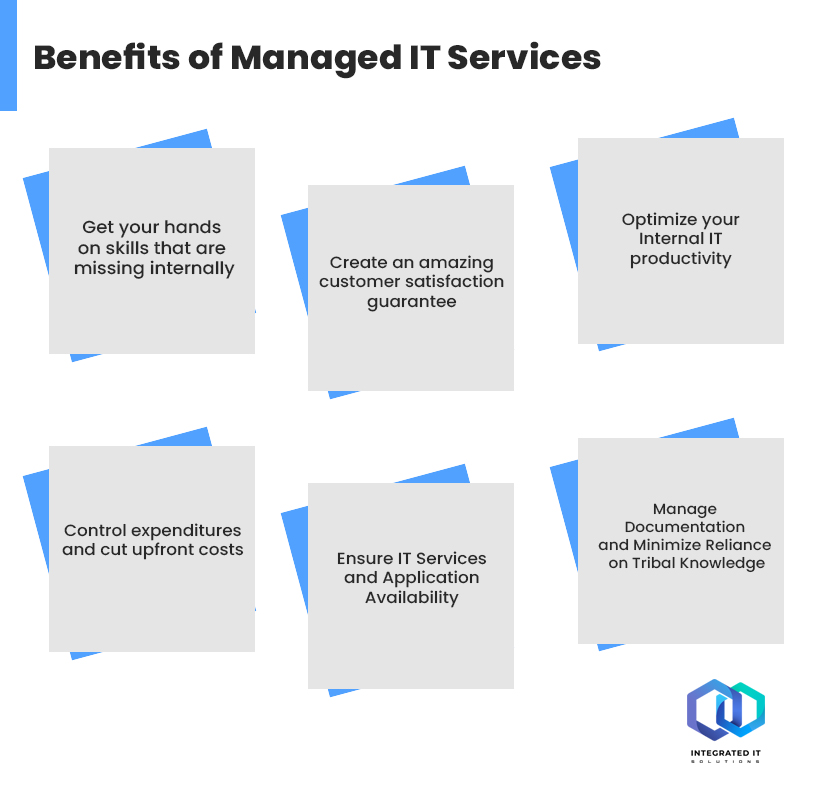In this digital age, the influence of technology on businesses is very huge. It needs efficient, on-time, and continuous management for effective communication, productivity, time-to-market, and business decision-making.
For this reason, businesses need to utilize Managed IT Services to manage day-to-day operations.
This article aims to explain the meaning, model, categories, benefits, and challenges of managed services.
What is Meant by Managed IT Services?
Managed IT services are defined as the process of fully or partially outsourcing technology-focused tasks and services to a third-party vendor. This third-party vendor typically operates remotely or even from an offshore location.
However, the information technology tasks include, migration, implementation, maintenance and
upgrading different parts of IT infrastructure (including backup and security).
In simple words, instead of hiring an internal IT manager, you can partner with a manager service provider (MSP), and they will become your trusted advisor.
What is the Managed IT Services Model?
Managed service providers (MSPs) support a company’s tech needs via ongoing IT support. This may include setup, installation, configuration, and monitoring of a company’s networks and endpoints.
They typically offer services at a flat and recurring rate in tiered levels. For example, as the quality of service increases clients receive more automation and management per their service level agreement (SLA).
IT-managed services enable partners to manage their organization more smoothly and efficiently. In addition to this, they offer software-as-a-service (SaaS), at a rate that inhouse options can’t beat.
Categories of Managed IT Services
There’s a broad spectrum of MSP services for their customer base. Managed IT services can be classified as follows

1. Remote Infrastructure Management Services
The first common category of managed IT service comes from remote infrastructure management. Remote management and monitoring is a significant, core service for a supplier of managed services.
And, since different MSPs provide this service, competition is high, and revenue levels have been under pressure. But this has led to a new and more specialized category of managed IT services, like the ones we’ll discuss below.
2. End-user Services
Next comes end-user services. This includes a diverse range of solutions, but they often revolve around the IT assistance channels and processes. For example, at the most basic level, there is an IT help desk or service desk solution through which users can simplify technical hurdles with a group of skilled agents.
3. Cyber Security Services
Managed cybersecurity is a robust tool that can help enable you to secure confidential data from cyber attacks. An MSP can prove to be valuable in guiding you to choose the right type of digital network security services for your business.
4. Managed Cloud Services
With the advent of cloud technology, managed IT services have expanded to a greater extent. Managed IT services can also cover the implementation and management of the cloud for instance consulting, assessments, migrations, and much more.
5. On-site IT Services
Also known as managed field services, on-site IT services include an MSP assigning experts to a designated area to carry out IT practices. This includes equipment installations, site assessments, etc.
Additionally, here the provider is responsible for scheduling and deploying technicians, managing issue logs and service requests, and enabling post-task communications.
6. Project-based Services
Another type of managed IT service is project-based managed IT service. This project-specific technology includes solution expertise, technology evaluation, or consistent technical support for business apps.
Despite this, a good MSP will possess a set framework. He or she will offer a project schedule and decide on a budget without exceeding budgetary and scheduling parameters.
7. Managed Communication Services
Enterprise communication comes under the category of IT. You will most probably select to outsource the administration of communication systems by acquiring managed IT services. Managed communications are often referred to as unified communication. It integrates telephonic, multimedia, and data communication into a single, unified hub.
8. Managed Data Analytics Services
These services guide the gathering, assessment, and protection of user and consumer data. This includes checking site traffic or social networking participation, identifying trends, and forecasting future outcomes.
But, here the MSP can transform raw data into insights that are easy to comprehend and ready to be utilized in business decision-making.
9. Managed Print Services
Last but not least, managed print services allow the service provider to virtually monitor hardware and provide timely support, updates, upkeep, and repair. This type of managed IT service will significantly cover needs evaluation, hardware replacement, maintenance, and supplies.
10. Managed Backup Services
Lastly, data backup may be coupled with other managed services. These services include network, security, and cloud computing. Along with this, some service providers provide an additional, comprehensive solution.
Here MSPs may assist with identifying your backup requirement, suggesting how reliable backups should be done. And also allowing the scope and extent of the recovery program.
What are the Key Benefits of Managed IT Services?
Besides handling all IT practices in-house, most companies currently opt for fully or partially outsourced IT-managed services. They do this for the sake of the following benefits:

1. Get your hands on skills that are missing internally
Firstly, managed services might be beneficial for folks who do not have the required experience to handle specific business processes. Thus having a hand of experts to deliver a service relieves the stress of your workforce to concentrate on innovation rather than repetitive tasks.
2. Create an amazing customer satisfaction guarantee
Secondly, managed service providers are accountable for ensuring the service’s availability at all times. Thus businesses are free from all worries about interruptions. Services and IT support are delivered according to an SLA. It clarifies what to anticipate and at what time.
3. Optimize your Internal IT productivity
Thirdly, through outsourcing IT responsibilities to managed services, employees can concentrate on revenue-generating initiatives. Furthermore, you do not have to invest time in locating, employing, or training IT workers.
Occasionally, managed IT service providers may also offer counsel or recommendations to guide organization efficiency.
4. Control expenditures and cut upfront costs
Fourthly, the cost associated with MSP subscription plans is often regular and foreseeable. So businesses may handle their monthly, quarterly, or annual IT budgets seamlessly. Along with this, another benefit of managed IT services is inexpensive access to the latest innovations.
5. Ensure IT Services and Application Availability
Last but not least, managed IT services use remote monitoring technologies to maintain your IT platforms round-the-clock. Real-time notifications enable you to address issues prior to them having a major influence on your company.
6. Manage Documentation and Minimize Reliance on Tribal Knowledge
Finally, with the greater maintenance of daily activities and tickets, modifications and updates could well be executed, even without documentation. When an IT manager retires from his or her position, a knowledge gap develops leaving everyone uncertain about the way forward.
Hence, a loyal MSP will follow the standard methodology and document the significant conditions of the business environment.
What are the Challenges Connected with Managed IT Services?
1. Zero Accountability
Outsourcing your IT responsibilities to the wrong vendor may lead to dissatisfaction and financial loss. When choosing a vendor, one must ensure that their SLAs are well-defined and practical.
2. Lack of Clarity in Business Requirements
MSPs must guide the strategic planning of infrastructure enhancements, configuration updates, and other improvements. So beyond the near future, the process must be expanded to greater levels.
3. Little or almost no experience
We all know that all service providers aren’t comparable. Check the working record of service providers with other companies in your sector to scale the category. If a supplier is not willing to provide evidence of service quality, then it means they are not a good investment option.
4. Cyber Threats
Most MSPs are not experienced in cybersecurity, leaving companies vulnerable in the hands of cybercriminals. The IT MSP’s main focus should be the safety and security of confidential data especially in the case of a data breach.
5. Cost Problems
The main concern for hiring a managed IT services provider is to balance and safeguard IT investments. However, you may find that costs differ considerably from your expectations.
Therefore, the costs must be laid out in the SLAs, and a breach should result in termination.
Final Thoughts
Managed IT services are essential in this current digital age. As our speed of digital transformation expedites, your IT infrastructure will expand from all angles. Here, a managed IT service provider can streamline its upkeep and also make it simple to deploy and gain benefits from the latest technologies.
We hope this article helped you understand the concept of managed service. Tell us at Integrated IT Solutions. We’re excited to hear from you!



